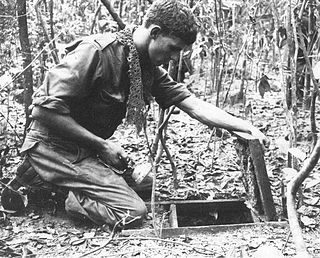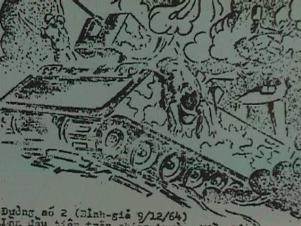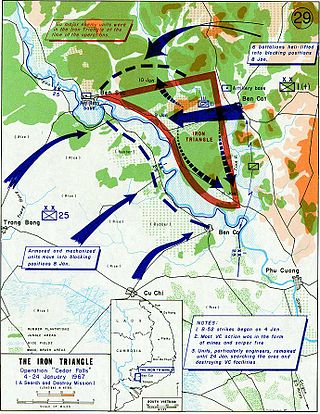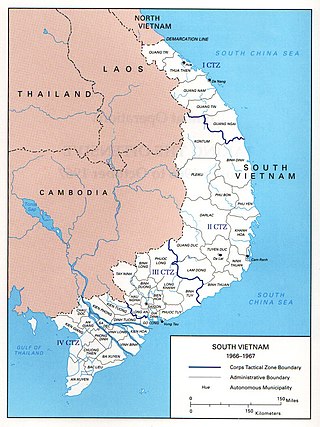
An ambush is a surprise attack carried out by people lying in wait in a concealed position. The concealed position itself or the concealed person(s) may also be called an "ambush". Ambushes as a basic fighting tactic of soldiers or of criminals have been used consistently throughout history, from ancient to modern warfare.

The Vietnam War was a conflict in Vietnam, Laos, and Cambodia from 1 November 1955 to the fall of Saigon on 30 April 1975. It was the second of the Indochina Wars and was a major conflict of the Cold War. While the war was officially fought between North Vietnam and South Vietnam, the north was supported by the Soviet Union, China, and other communist states, while the south was supported by the United States and other anti-communist allies, making the war a proxy war between the United States and the Soviet Union. It lasted almost 20 years, with direct U.S. military involvement ending in 1973. The conflict also spilled over into neighboring states, exacerbating the Laotian Civil War and the Cambodian Civil War, which ended with all three countries officially becoming communist states by 1976.

The Viet Cong was an epithet and umbrella term to call the communist-driven armed movement and united front organization in South Vietnam, Laos and Cambodia. Formally organized as and led by the National Liberation Front of South Vietnam, it fought under the direction of North Vietnam against the South Vietnamese and United States governments during the Vietnam War. The organization had both guerrilla and regular army units, as well as a network of cadres who organized and mobilized peasants in the territory the Viet Cong controlled. During the war, communist fighters and some anti-war activists claimed that the Viet Cong was an insurgency indigenous to the South that represented the legitimate rights of people in South Vietnam, while the U.S. and South Vietnamese governments portrayed the group as a tool of North Vietnam. It was later conceded by the modern Vietnamese communist leadership that the movement was actually under the North Vietnamese political and military leadership, aiming to unify Vietnam under a single banner.

The Malayan Emergency, also known as the Anti–British National Liberation War(1948–1960), was a guerrilla war fought in British Malaya between communist pro-independence fighters of the Malayan National Liberation Army (MNLA) and the military forces of the Federation of Malaya, British Empire and Commonwealth. The communists fought to win independence for Malaya from the British Empire and to establish a socialist economy, while the Malayan Federation and Commonwealth forces fought to combat communism and protect British economic and colonial interests. The term "Emergency" was used by the British to characterise the conflict in order to avoid referring to it as a war, because London-based insurers would not pay out in instances of civil wars.
People's war or protracted people's war is a Maoist military strategy. First developed by the Chinese communist revolutionary leader Mao Zedong (1893–1976), the basic concept behind people's war is to maintain the support of the population and draw the enemy deep into the countryside where the population will bleed them dry through guerrilla warfare and eventually build up to mobile warfare. It was used by the Chinese communists against the Imperial Japanese Army in World War II, and by the Chinese Soviet Republic in the Chinese Civil War.

The Strategic Hamlet Program was a plan by the government of South Vietnam in conjunction with the US government and ARPA during the Vietnam War to combat the communist insurgency by pacifying the countryside and reducing the influence of the communists among the rural population.

Hearts and Minds or winning hearts and minds refers to the strategy and programs used by the governments of Vietnam and the United States during the Vietnam War to win the popular support of the Vietnamese people and to help defeat the Viet Cong insurgency. Pacification is the more formal term for winning hearts and minds. In this case, however, it was also defined as the process of countering the insurgency. Military, political, economic, and social means were used to attempt to establish or reestablish South Vietnamese government control over rural areas and people under the influence of the Viet Cong. Some progress was made in the 1967–1971 period by the joint military-civilian organization called CORDS, but the character of the war changed from a guerrilla war to a conventional war between the armies of South and North Vietnam. North Vietnam won in 1975.

The Iron Triangle was a 120 square miles (310 km2) area in the Bình Dương Province of Vietnam, so named due to it being a stronghold of Viet Minh activity during the war. The region was under control of the Viet Minh throughout the French war in Vietnam and continued to be so throughout the phase of American involvement in the Vietnam War, despite concerted efforts on the part of US and South Vietnamese forces to destabilize the region as a power base for their enemy, the communist North Vietnamese–sponsored and–directed South Vietnamese insurgent movement, the Viet Cong (VC).

Operation Crimp, also known as the Battle of the Ho Bo Woods, was a joint US-Australian military operation during the Vietnam War, which took place 20 kilometres (12 mi) north of Cu Chi in Binh Duong Province, South Vietnam. The operation targeted a key Viet Cong headquarters that was believed to be concealed underground, and involved two brigades under the command of the US 1st Infantry Division, including the 1st Battalion, Royal Australian Regiment which was attached to the US 173rd Airborne Brigade. Heavy fighting resulted in significant casualties on both sides, but the combined American and Australian force was able to uncover an extensive tunnel network covering more than 200 kilometres, at the cost of 8 Australians and 14 Americans killed and 29 Australians and 76 Americans wounded.

The Battle of Bình Giã was conducted by the Viet Cong (VC) and People's Army of Vietnam (PAVN) from December 28, 1964, to January 1, 1965, during the Vietnam War in Bình Giã, Phước Tuy province, South Vietnam.

Operation Cedar Falls was a military operation of the Vietnam War conducted primarily by US forces that took place from 8 to 26 January 1967. The aim of the massive search-and-destroy operation was to eradicate the Iron Triangle, an area northwest of Saigon that had become a major stronghold of the Viet Cong (VC).
During the Second Indochina War, better known as the Vietnam War, a distinctive land warfare strategy and organization was used by the National Liberation Front of South Vietnam (NLF) or better known as the Viet Cong (VC) in the West, and the People's Army of Vietnam (PAVN) or North Vietnamese Army (NVA) to defeat their American and South Vietnamese Army of the Republic of Vietnam (ARVN) opponents. These methods involved closely integrated political and military strategy – what was called dau tranh - literally "to struggle". The National Liberation Front, (NLF) was an umbrella of front groups, sympathizers and allies set up by the rulers of North Vietnam to conduct the insurgency in South Vietnam. The NLF also included fully armed formations- regional and local guerrillas, and the People's Liberation Armed Forces (PLAF). The PLAF was the "Main Force" – the Chu Luc or full-time soldiers of the NLF's military wing. Many histories lump both the NLF and the armed formations under the term "Viet Cong" or "VC" in common usage. Both were tightly interwoven and were in turn controlled by the North. Others consider the Viet Cong, or "VC" to primarily refer to the armed elements. The term PAVN, identifies regular troops of the North Vietnamese Army or NVA as they were commonly known by their Western opponents. Collectively, both forces- the southern armed wing and the regulars from the north were part of PAVN.
United States involvement in the Vietnam War began shortly after the end of World War II in Asia, first in an extremely limited capacity and escalating over a period of 20 years. The U.S. military presence peaked in April 1969, with 543,000 American combat troops stationed in Vietnam. By the conclusion of the United States's involvement in 1973, over 3.1 million Americans had been stationed in Vietnam.

VC and PAVN battle tactics comprised a flexible mix of guerrilla and conventional warfare battle tactics used by Viet Cong (VC) and the North Vietnamese People's Army of Vietnam (PAVN) to defeat their U.S. and South Vietnamese (GVN/ARVN) opponents during the Vietnam War.
The main strategy and tactics of guerrilla warfare tend to involve the use of a small attacking, mobile force against a large, unwieldy force. The guerrilla force is largely or entirely organized in small units that are dependent on the support of the local population. Tactically, the guerrilla army makes the repetitive attacks far from the opponent's center of gravity with a view to keeping its own casualties to a minimum and imposing a constant debilitating strain on the enemy. This may provoke the enemy into a brutal, excessively destructive response which will both anger their own supporters and increase support for the guerrillas, ultimately compelling the enemy to withdraw. One of the most famous examples of this was during the Irish War of Independence. Michael Collins, a leader of the Irish Republican Army, often used this tactic to take out squads of British soldiers, mainly in Munster, especially Cork.

During the Cold War in the 1960s, the United States and South Vietnam began a period of gradual escalation and direct intervention referred to as the "Americanization" of joint warfare in South Vietnam during the Vietnam War. At the start of the decade, United States aid to South Vietnam consisted largely of supplies with approximately 900 military observers and trainers. After the assassination of both Ngo Dinh Diem and John F. Kennedy close to the end of 1963 and Gulf of Tonkin incident in 1964 and amid continuing political instability in the South, the Lyndon Johnson Administration made a policy commitment to safeguard the South Vietnamese regime directly. The American military forces and other anti-communist SEATO countries increased their support, sending large scale combat forces into South Vietnam; at its height in 1969, slightly more than 400,000 American troops were deployed. The People's Army of Vietnam and the allied Viet Cong fought back, keeping to countryside strongholds while the anti-communist allied forces tended to control the cities. The most notable conflict of this era was the 1968 Tet Offensive, a widespread campaign by the communist forces to attack across all of South Vietnam; while the offensive was largely repelled, it was a strategic success in seeding doubt as to the long-term viability of the South Vietnamese state. This phase of the war lasted until the election of Richard Nixon and the change of U.S. policy to Vietnamization, or ending the direct involvement and phased withdrawal of U.S. combat troops and giving the main combat role back to the South Vietnamese military.

The Battle of Suối Châu Pha was fought during the Vietnam War between Australian troops and the Việt Cộng. The battle took place during Operation Ballarat, an Australian search and destroy operation in the eastern Hát Dịch area, north-west of Núi Đất in Phước Tuy province. Following a covert insertion the day before which had caught a number of Việt Cộng sentries by surprise, A Company, 7th Battalion, Royal Australian Regiment had patrolled forward unaware of the presence of a large Việt Cộng main force unit nearby. Clashing with a reinforced company from the Việt Cộng 3rd Battalion, 274th Regiment, a classic encounter battle ensued between two forces of roughly equal size. Fought at close quarters in dense jungle amid a heavy monsoon rain, both sides suffered heavy casualties as neither was able to gain an advantage. Finally, after a battle lasting several hours, the Australian artillery proved decisive and the Việt Cộng were forced to withdraw, dragging many of their dead from the battlefield after having suffered crippling losses.
"The General Goes Zapping Charlie Cong" is an example of The New Journalism by Nicholas Tomalin, an English journalist, in 1966. It relates a day’s activities of General James F. Hollingsworth during the Vietnam War. It first appeared in the British newspaper The Sunday Times.

Operation Crazy Horse, named after Lakota warrior Crazy Horse, was a search and destroy mission during the Vietnam War conducted by military forces of the United States, South Vietnam, and the Republic of South Korea in two valleys in Bình Định Province of South Vietnam.
The Vietnam War body count controversy centers on the counting of enemy dead by the United States Armed Forces during the Vietnam War (1955–1975). There are issues around killing and counting unarmed civilians (non-combatants) as enemy combatants, as well as inflating the number of actual enemy who were killed in action (KIA). For search and destroy operations, as the objective was not to hold territory or secure populations, victory was assessed by having a higher enemy body count.














